Product Images Ingrezza
View Photos of Packaging, Labels & Appearance
Product Label Images
The following 10 images provide visual information about the product associated with Ingrezza NDC 70370-2040 by Neurocrine Biosciences, Inc., such as packaging, labeling, and the appearance of the drug itself. This resource could be helpful for medical professionals, pharmacists, and patients seeking to verify medication information and ensure they have the correct product.
The following chemical structure of INGREZZA contains valbenazine, a selective vesicular monoamine transporter 2 inhibitor, present as valbenazine tosylate salt, with the chemical name, L-Valine, (2R,3R,11bR)-1,3,4,6,7,11b-hexahydro-9,10-dimethoxy-3-(2-methylpropyl)-2H-benzo[a]quinolizin-2-yl ester, 4-methylbenzenesulfonate (1:2). Valbenazine tosylate is slightly soluble in water. Its molecular formula is C38H54N2O10S2, and its molecular weight is 762.97 g/mol (ditosylate salt). - valbenazine 01
![valbenazine-01.jpg The following chemical structure of INGREZZA contains valbenazine, a selective vesicular monoamine transporter 2 inhibitor, present as valbenazine tosylate salt, with the chemical name, L-Valine, (2R,3R,11bR)-1,3,4,6,7,11b-hexahydro-9,10-dimethoxy-3-(2-methylpropyl)-2H-benzo[a]quinolizin-2-yl ester, 4-methylbenzenesulfonate (1:2). Valbenazine tosylate is slightly soluble in water. Its molecular formula is C38H54N2O10S2, and its molecular weight is 762.97 g/mol (ditosylate salt). - valbenazine 01](https://ndclist.com/assets/spl/images/4c970164-cafb-421f-9eb5-c226ef0a3417/400x-valbenazine-01.jpg)
Figure 2: Effects of Strong CYP3A4 Inducers and Inhibitors on Valbenazine Pharmacokinetics - valbenazine 03
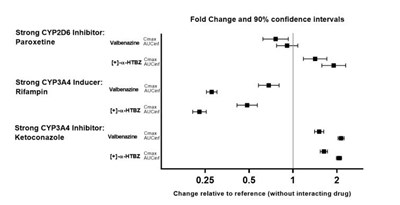
This appears to be a table or chart showing the effects of various drugs on the activity of certain enzymes. The drugs mentioned include Paroxetine, Vaibenazine, ElaHTez, Fong, Rifampin, T1ranTez, and Ketoconazole. Additionally, the table shows fold change and confidence intervals for drug interactions with certain enzymes (CYP2DS and CYP3A4). The chart also displays a reference point without any interacting drugs, and values for changes at different ratios of interacting drugs.*
Figure 3: Effects of Valbenazine on Pharmacokinetics of Other Drugs - valbenazine 04
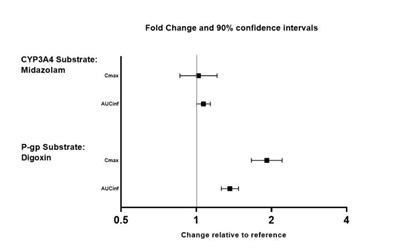
This is a table with information about the pharmacokinetics of two drugs: Midazolam and Digoxin. Midazolam is a substrate of the CYP3A4 enzyme while Digoxin is a substrate of the P-gp transporter. The table reports the Cmax and AUCint values for both drugs, but there is not enough information to determine the units or the experimental conditions. Additionally, there is a row labeled "Fold Change and 90% confidence intervals" but it is not clear what this refers to, as the only value provided is 0.5.*
Figure 4: Percent of Patients with Specified Magnitude of AIMS Total Score Improvement at the End of Week 6 - valbenazine 05

Figure 5: AIMS Dyskinesia Total Score Mean Change from Baseline – Entire Study Duration (Arithmetic Mean) - valbenazine 06
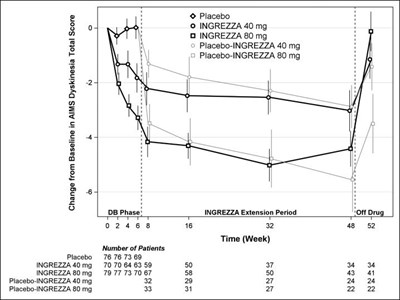
This appears to be a table or graph showing the different treatment groups and their respective scores on the AIMS Dyskinesia Total Score. The treatments being compared are placebo, INGREZZA 40 mg, and INGREZZA 80 mg, with additional groups receiving combinations of placebo and INGREZZA at varying doses. The data may be from a clinical trial with different time points (in weeks) and the number of patients in each group is also included. Overall, it is not entirely clear what the data represents without additional context.*
NDC 70370-1040-1INGREZZA(valbenazine) capsules40 mg30 CapsulesRx Only - valbenazine 07
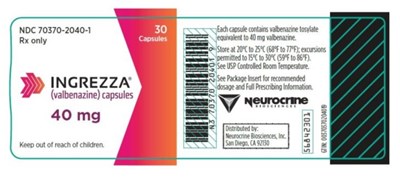
NDC 70370-2040-1 is a prescription drug used to treat Tardive Dyskinesia. It is an Ingrezza capsule that contains 40 mg of valbenazine. The recommended dose can be found in the packaging material provided by the manufacturer - Neurocrin Biosciences. It should be stored at a controlled room temperature and kept out of reach of children.*
NDC 70370-1080-1INGREZZA(valbenazine) capsules80 mg30 CapsulesRx Only - valbenazine 08

This is a prescription drug labeled INGREZZA, containing a substance called valbenazine. It is manufactured by Neurocrine Biosciences, Inc. This medication comes in capsule form and is recommended for the treatment of neurological disorders. The package is child-resistant, and the drug must be kept out of the reach of children. The NDC number for this medication is 70370-10601. The complete prescribing information is available and controlled room temperature must be maintained for this drug.*
valbenazine 09
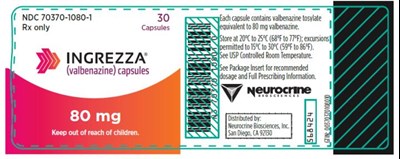
This is a medication called INGREZZA, which is available only with a prescription. It comes in the form of capsules with a strength of 80 mg, and the active ingredient is valbenazine. It is important to keep the medication out of reach of children and store it within the recommended temperature range of 20° to 25° Celsius (68° to 77° Fahrenheit), with permitted excursions between 15° to 30° Celsius (59° to 86° Fahrenheit). The distributor of the medication is Neurocrine Biosciences, based in San Diego, California.*
valbenazine 0a
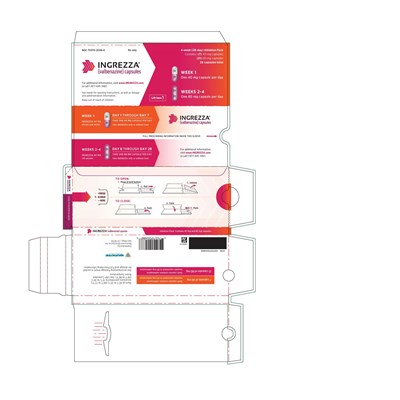
The text is a prescription drug label for Reonly 4-week Initiation Pack containing INGREZZA (valbenazine) capsules. The pack consists of seven capsules that should be taken once daily. The first week requires one 40mg capsule per day, and subsequent weeks two through four require one 80mg capsule per day. The drug is not meant for children, and the full prescribing information is inside the sleeve. The text also contains instructions for opening and closing the sleeve.*
* The product label images have been analyzed using a combination of traditional computing and machine learning techniques. It should be noted that the descriptions provided may not be entirely accurate as they are experimental in nature. Use the information in this page at your own discretion and risk.
